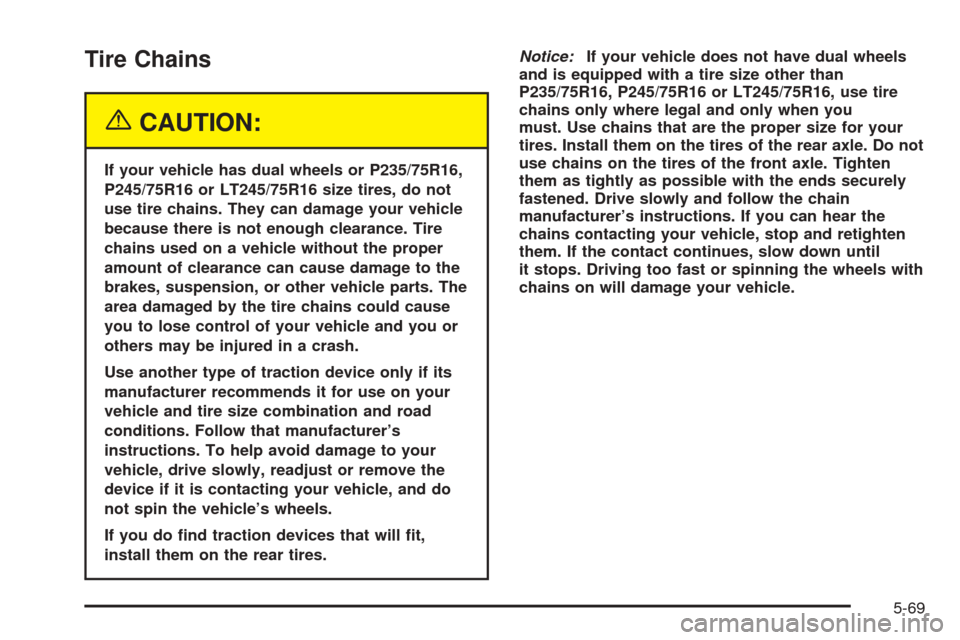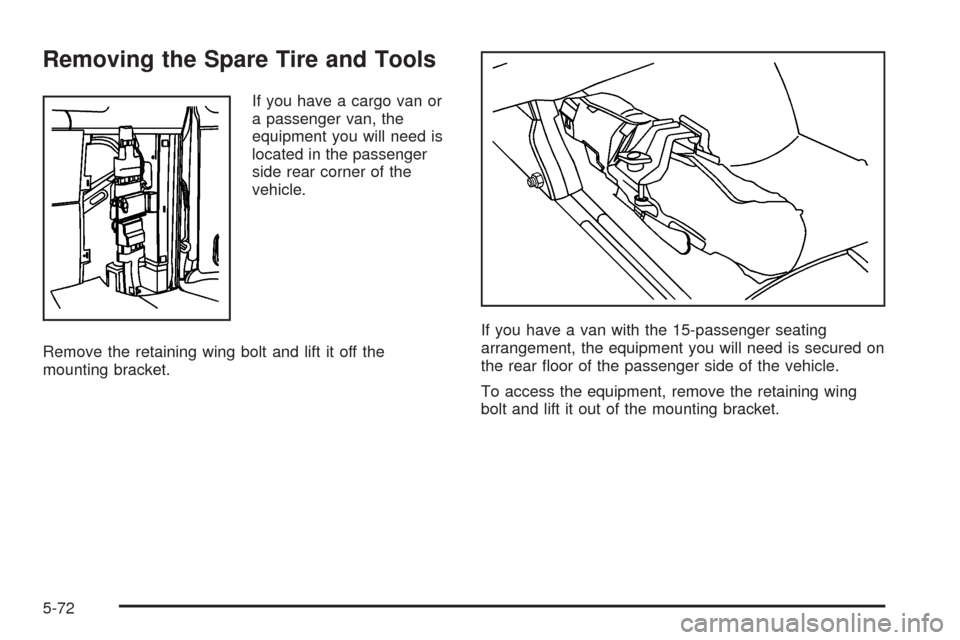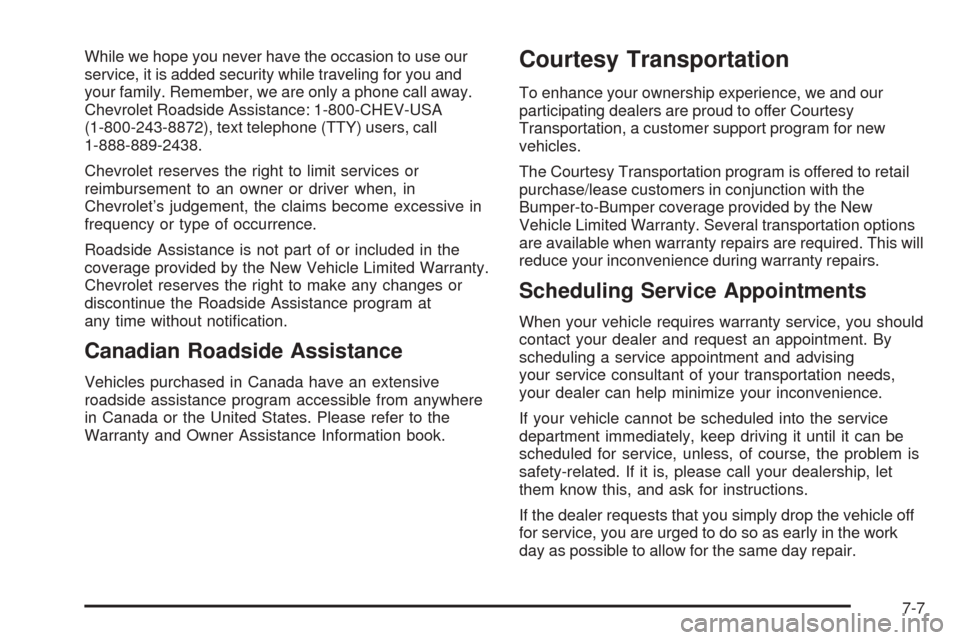2005 CHEVROLET EXPRESS PASSANGER ECU
[x] Cancel search: ECUPage 304 of 388

Dual Tire Operation
When the vehicle is new, or whenever a wheel, wheel
bolt or wheel nut is replaced, check the wheel nut torque
after 100, 1,000 and 6,000 miles (160, 1 600 and
10 000 km) of driving. For proper wheel nut tightening
information, see “Removing the Flat Tire and Installing
the Spare Tire” later in this section, underChanging
a Flat Tire on page 5-70. Also see “Wheel Nut Torque”
underCapacities and Speci�cations on page 5-100.
The outer tire on a dual wheel setup generally wears
faster than the inner tire. Your tires will wear more
evenly and last longer if you rotate the tires periodically.
SeeTire Inspection and Rotation on page 5-62. Also
seeScheduled Maintenance on page 6-4.
{CAUTION:
If you operate your vehicle with a tire that is
badly underin�ated, the tire can overheat. An
overheated tire can lose air suddenly or catch
�re. You or others could be injured. Be sure all
tires (including the spare) are properly in�ated.
SeeTires on page 5-53andIn�ation - Tire Pressure on
page 5-60for more information on proper tire in�ation.
Tire Inspection and Rotation
Tires should be rotated every 5,000 to 8,000 miles
(8 000 to 13 000 km).
Any time you notice unusual wear, rotate your tires as
soon as possible and check wheel alignment. Also
check for damaged tires or wheels. SeeWhen It Is Time
for New Tires on page 5-64andWheel Replacement
on page 5-67for more information.
Make sure the spare tire is stored securely. Push, pull,
and then try to rotate or turn the tire. If it moves,
use the ratchet/wheel wrench to tighten the cable. See
Changing a Flat Tire on page 5-70.
If your vehicle has dual rear wheels, also seeDual Tire
Operation on page 5-62.
The purpose of regular rotation is to achieve more
uniform wear for all tires on the vehicle. The �rst rotation
is the most important. SeeScheduled Maintenance
on page 6-4.
5-62
Page 311 of 388

Tire Chains
{CAUTION:
If your vehicle has dual wheels or P235/75R16,
P245/75R16 or LT245/75R16 size tires, do not
use tire chains. They can damage your vehicle
because there is not enough clearance. Tire
chains used on a vehicle without the proper
amount of clearance can cause damage to the
brakes, suspension, or other vehicle parts. The
area damaged by the tire chains could cause
you to lose control of your vehicle and you or
others may be injured in a crash.
Use another type of traction device only if its
manufacturer recommends it for use on your
vehicle and tire size combination and road
conditions. Follow that manufacturer’s
instructions. To help avoid damage to your
vehicle, drive slowly, readjust or remove the
device if it is contacting your vehicle, and do
not spin the vehicle’s wheels.
If you do �nd traction devices that will �t,
install them on the rear tires.Notice:If your vehicle does not have dual wheels
and is equipped with a tire size other than
P235/75R16, P245/75R16 or LT245/75R16, use tire
chains only where legal and only when you
must. Use chains that are the proper size for your
tires. Install them on the tires of the rear axle. Do not
use chains on the tires of the front axle. Tighten
them as tightly as possible with the ends securely
fastened. Drive slowly and follow the chain
manufacturer’s instructions. If you can hear the
chains contacting your vehicle, stop and retighten
them. If the contact continues, slow down until
it stops. Driving too fast or spinning the wheels with
chains on will damage your vehicle.
5-69
Page 314 of 388

Removing the Spare Tire and Tools
If you have a cargo van or
a passenger van, the
equipment you will need is
located in the passenger
side rear corner of the
vehicle.
Remove the retaining wing bolt and lift it off the
mounting bracket.If you have a van with the 15-passenger seating
arrangement, the equipment you will need is secured on
the rear �oor of the passenger side of the vehicle.
To access the equipment, remove the retaining wing
bolt and lift it out of the mounting bracket.
5-72
Page 327 of 388

3. Pull the wheel toward the rear of the vehicle,
keeping the cable tight.
4. With the UP side facing you, attach the ratchet to
the wheel wrench.5. Put the �at end of the wheel wrench on an angle
through the hole in the rear door frame, above the
bumper.
6. Raise the tire fully against the underside of the
vehicle. Continue turning the ratchet until the tire
is secure and the cable is tight. The spare tire hoist
cannot be overtightened.
7. Make sure the tire is stored securely. Push, pull,
and then try to rotate or turn the tire. If the tire
moves, use the ratchet to tighten the cable.
You will hear two clicks when the tire is up all the way.
Return the jacking equipment to the proper location.
Secure the items and replace the jack cover.
5-85
Page 354 of 388

Windshield Washer Fluid Level Check
Check the windshield washer �uid level in the windshield
washer tank and add the proper �uid if necessary.
At Least Once a Month
Tire In�ation Check
Visually inspect your vehicle’s tires and make sure they
are in�ated to the correct pressures. Do not forget to
check the spare tire. SeeTires on page 5-53for further
details. Check to make sure the spare tire is stored
securely. SeeChanging a Flat Tire on page 5-70.
Tire Wear Inspection
Tire rotation may be required for high mileage highway
drivers prior to the Engine Oil Life System service
noti�cation. Check the tires for wear and, if necessary,
rotate the tires. SeeTire Inspection and Rotation on
page 5-62.
At Least Once a Year
Starter Switch Check
{CAUTION:
When you are doing this inspection, the
vehicle could move suddenly. If the vehicle
moves, you or others could be injured.
1. Before you start, be sure you have enough room
around the vehicle.
2. Firmly apply both the parking brake and the regular
brake. SeeParking Brake on page 2-26.
Do not use the accelerator pedal, and be ready to
turn off the engine immediately if it starts.
3. Try to start the engine in each gear. The vehicle
should start only in PARK (P) or NEUTRAL (N).
If the vehicle starts in any other position, contact
your GM Goodwrench
®dealer for service.
6-10
Page 369 of 388

While we hope you never have the occasion to use our
service, it is added security while traveling for you and
your family. Remember, we are only a phone call away.
Chevrolet Roadside Assistance: 1-800-CHEV-USA
(1-800-243-8872), text telephone (TTY) users, call
1-888-889-2438.
Chevrolet reserves the right to limit services or
reimbursement to an owner or driver when, in
Chevrolet’s judgement, the claims become excessive in
frequency or type of occurrence.
Roadside Assistance is not part of or included in the
coverage provided by the New Vehicle Limited Warranty.
Chevrolet reserves the right to make any changes or
discontinue the Roadside Assistance program at
any time without noti�cation.
Canadian Roadside Assistance
Vehicles purchased in Canada have an extensive
roadside assistance program accessible from anywhere
in Canada or the United States. Please refer to the
Warranty and Owner Assistance Information book.
Courtesy Transportation
To enhance your ownership experience, we and our
participating dealers are proud to offer Courtesy
Transportation, a customer support program for new
vehicles.
The Courtesy Transportation program is offered to retail
purchase/lease customers in conjunction with the
Bumper-to-Bumper coverage provided by the New
Vehicle Limited Warranty. Several transportation options
are available when warranty repairs are required. This will
reduce your inconvenience during warranty repairs.
Scheduling Service Appointments
When your vehicle requires warranty service, you should
contact your dealer and request an appointment. By
scheduling a service appointment and advising
your service consultant of your transportation needs,
your dealer can help minimize your inconvenience.
If your vehicle cannot be scheduled into the service
department immediately, keep driving it until it can be
scheduled for service, unless, of course, the problem is
safety-related. If it is, please call your dealership, let
them know this, and ask for instructions.
If the dealer requests that you simply drop the vehicle off
for service, you are urged to do so as early in the work
day as possible to allow for the same day repair.
7-7
Page 379 of 388

Child Restraints
Child Restraint Systems...............................1-40
Infants and Young Children...........................1-33
Lower Anchorages and Top Tethers for
Children (LATCH System)..........................1-50
Older Children.............................................1-30
Securing a Child Restraint Designed for the
LATCH System........................................1-52
Securing a Child Restraint in a Center
Seat Position...........................................1-56
Securing a Child Restraint in a Rear
Outside Seat Position...............................1-53
Securing a Child Restraint in the Right
Front Seat Position...................................1-57
Top Strap...................................................1-47
Top Strap Anchor Location............................1-48
Where to Put the Restraint...........................1-43
Chime Level Adjustment..................................3-73
Cigarette Lighter.............................................3-17
Cleaning
Aluminum Wheels........................................5-92
Exterior Lamps/Lenses.................................5-90
Fabric/Carpet..............................................5-88
Finish Care.................................................5-90
Inside of Your Vehicle..................................5-87
Instrument Panel, Vinyl, and Other Plastic
Surfaces.................................................5-89
Tires..........................................................5-92
Underbody Maintenance...............................5-93
Washing Your Vehicle...................................5-90Cleaning (cont.)
Weatherstrips..............................................5-89
Windshield and Wiper Blades........................5-91
Climate Control System...................................3-18
Outlet Adjustment........................................3-20
Rear Air Conditioning and Heating System......3-22
Rear Heating System...................................3-21
Comfort Guides, Rear Safety Belt.....................1-27
Control of a Vehicle.......................................... 4-5
Coolant
Engine Temperature Gage............................3-33
Heater, Engine............................................2-22
Cooling System..............................................5-26
Cruise Control................................................3-10
Cruise Control Light........................................3-38
Customer Assistance Information
Courtesy Transportation.................................. 7-7
Customer Assistance for Text
Telephone (TTY) Users............................... 7-4
Customer Assistance Offices........................... 7-4
Customer Satisfaction Procedure..................... 7-2
GM Mobility Reimbursement Program............... 7-5
Reporting Safety Defects to General Motors....7-12
Reporting Safety Defects to the
Canadian Government..............................7-11
Reporting Safety Defects to the
United States Government.........................7-11
Roadside Assistance Program......................... 7-6
Service Publications Ordering Information........7-12
3
Page 380 of 388

D
Daytime Running Lamps..................................3-14
Daytime Running Lamps Indicator Light.............3-39
Defensive Driving............................................. 4-2
Doing Your Own Service Work........................... 5-4
Dome Lamp Override......................................3-15
Dome Lamps.................................................3-15
Door
60/40 Swing-Out Side Door...........................2-13
Cargo Door Relocking.................................... 2-9
Locks.......................................................... 2-7
Power Door Locks......................................... 2-8
Rear Door Security Locks............................... 2-9
Rear Doors.................................................2-14
Sliding Side Door........................................2-11
Driver
Position, Safety Belt.....................................1-15
Driving
At Night.....................................................4-16
City...........................................................4-20
Defensive..................................................... 4-2
Drunken....................................................... 4-2
Freeway.....................................................4-21
Hill and Mountain Roads..............................4-24
In Rain and on Wet Roads...........................4-18
Rocking Your Vehicle to Get it Out.................4-30
Winter........................................................4-26
Dual Tire Operation.........................................5-62
E
Electrical System
Add-On Equipment......................................5-95
Engine Compartment Fuse Block...................5-98
Floor Console Fuse Block.............................5-96
Fuses and Circuit Breakers...........................5-96
Headlamp Wiring.........................................5-95
Windshield Wiper Fuses...............................5-96
Engine
Air Cleaner/Filter.........................................5-18
Battery.......................................................5-38
Change Engine Oil Light...............................3-37
Check and Service Engine Soon Light............3-34
Coolant......................................................5-22
Coolant Heater............................................2-22
Coolant Temperature Gage...........................3-33
Engine Compartment Overview......................5-12
Exhaust.....................................................2-29
Fan Noise..................................................5-32
Fuel Regulator............................................2-22
Oil .............................................................5-13
Oil Life System...........................................5-16
Overheating................................................5-25
Reduced Power Light...................................3-38
Speed Limiter.............................................3-26
Starting......................................................2-21
Entry Lighting.................................................3-16
Event Data Recorders (EDR)............................. 7-9
Exit Lighting...................................................3-16
4